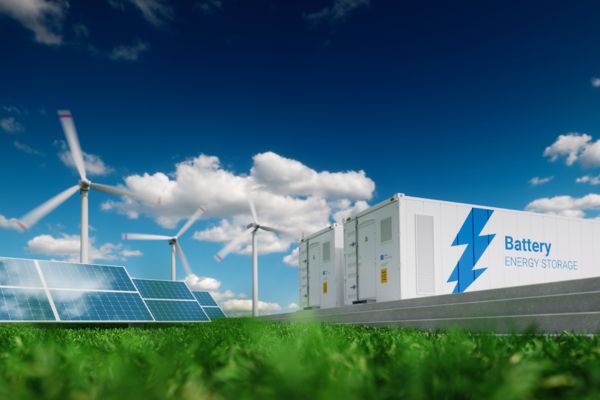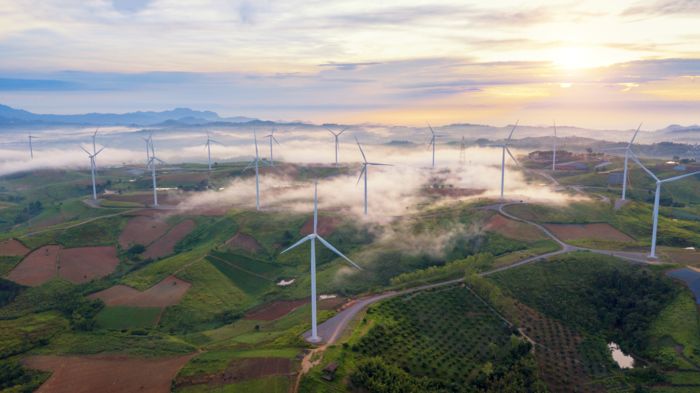Battery storage system as a functional booster for older wind farms Phoenix Contact uses open control technology to close the gap between power generation, storage, and further use.

Brief summary
When a fresh breeze blows, all those responsible for wind turbine generators are happy about the yields they reap from the power of the wind. If the wind is drops, nothing rotates – even if the demand for electrical energy remains. And this is exactly where renewable energy sources suffer, because they are not capable of being a stable source on their own. However, this will change at the latest when the parks have their own storage. Battery storage systems provide wind farms with a true functional booster in terms of efficiency, security of supply, and grid quality. In order to keep them connected to the grid for longer, older systems in particular can be effectively equipped with storage systems outside funding periods. Phoenix Contact is supporting this development with systems for installing energy storage from a building block system.

With a yield of 125.3 billion kWh, wind power is the most important source in Germany’s energy mix.
Combination of wind power and storage for a second life
In Germany, 46.2% of the gross electricity consumption is covered by renewable sources. The figure from the Federal Environment Agency relates to 2022 and, with a yield of 125.3 billion kWh, describes wind power as the most important carrier in the energy mix. According to Statista, the share of wind power was 21.7%.
What sounds good at first, however, should not hide the fact that, according to the Federal Environment Agency, a higher rate of expansion in wind power is required to achieve climate targets. In addition to further expansion, the question of how to handle wind turbine generators (WTGs) from earlier years of construction are also frequently discussed. These are primarily wind turbine generators that were built with state funding in the course of the German Renewable Energy Sources Act (EEG), which came into force in 2000. Today, this means that the first WTGs are a good 20 years old and are considered to be “exhausted”.
Due to the elimination of governmental remuneration, the economically motivated question arises for the operators as to whether the systems should be dismantled or simply continue operating. A third option: repowering in conjunction with industrial energy storage systems. With this buffer, older wind farms are also able to participate in the primary control power market. For this purpose, the combination of wind farm and storage system is best located at the common grid connection point. This creates a reserve unit which can provide primary control power through its energy storage system. This opens up a second life for aging wind farms, as completely new business and usage models are emerging when combined with energy storage.
Phoenix Contact is supporting this development with systems for installing energy storage from a building block system. Furthermore, the company also uses open control technology to close the gap between power generation, storage, and further use. The goal behind this is sector coupling, which Phoenix Contact continues to work on toward the All Electric Society.

Dr. Rüdiger Meyer is an expert for energy storage at Phoenix Contact
Three forms of control power to keep the grid stable
Primary control powers are necessary to keep the power grid stable. Naturally, this does not have a physical chance of storing energy. Consequently, the balance between supply and demand must be constantly managed. Here, the energy industry distinguishes between three forms of control power, which are defined by their availability over time. Primary control powers must be available within 30 s. In the case of secondary powers, there is five minutes time for the reserve, which then also has the task of taking over the scale of the primary power within 15 minutes – so that it can recover. The tertiary control power is also referred to as the minutes reserve power. It must also be available within 15 minutes for negative and positive control energy. For positive powers, power stations that can be ramped up quickly are usually used. Negative loads can be achieved with large loads such as electric arc furnaces, night storage heating systems, pumped storage plants, and even the controlled shutdown of wind turbine generators. All the measures outlined in brief together pursue the goal of ensuring grid stability. “If the load is too high, the frequency drops. If the load drops, it will increase. Both cases need to be avoided”, summarizes Dr. Rüdiger Meyer, application expert for energy storage at Phoenix Contact.
From the perspective of cost-effectiveness, quickly available gas turbine power stations for the minutes reserve power are just as inefficient as shutting down wind farms. On the one hand, electrical energy is generated with a high percentage of primary energy usage, while on the other the available kinetic energy of the wind is not utilized. In view of this dilemma, Dr. Rüdiger Meyer sees very good prospects for equipping existing wind farms with energy storage systems on an industrial scale. “If we combine wind farms with large-scale storage systems, the load distribution in the grid can be buffered. By having their own storage system, the wind turbines can therefore remain in the wind and generate energy when the grid is full”. In the opposite direction, power can be called up from the storage system even if there is no wind, which would also give the units an important role in grid stability.
Smoothing peak loads and earning money at the same time
And this is exactly where new fields of activity are developing in the direction of “repowering” for wind farms with earlier years of construction. The combination with storage systems based on lithium-ion batteries or redox-flow cells makes a valuable contribution to grid stability. In addition, they open up new earnings opportunities for operators – through arbitrage transactions. Here, the strongly fluctuating electricity prices have an effect on the spot market. The storage system absorbs the wind power during low tariff times and releases it again at higher prices in the event of peak loads that occur temporarily. This economic model is undoubtedly monetary motivated, but it shows that power generation and energy consumption can be temporally separated with the help of storage systems. This decoupling therefore brings new opportunities for sector coupling on the path to the All Electric Society.
Phoenix Contact provides solutions for this that have already been prepared today, right through to ready-to-install partial applications for the equipment of wind turbine generators. The scope of functions extends all the way up to cloud applications, including the integration of current and future communication standards. The open PLCnext control platform plays a key role here, as it can be used to easily meet individual requirements. This also includes IoT-based business models. These are necessary with regard to cloud-based services and database-supported information processes. At the hardware level, complete solutions for feed-in management, among other things, are used. The broad system features connection solutions for power electronics in all cross-sections, for example. In addition, Phoenix Contact provides prepared applications for network monitoring. Mandatory: effective and reliable protection against lightning strikes by means of high-performance lightning arresters.
Renewable hybrid power stations
“Today, with our entire portfolio, we are fortunate to be able to support the repowering of wind farms with industrial energy storage systems – right through to engineering. In this way, we are creating an essential basis for sector coupling”, summarizes Dr. Rüdiger Meyer. Upgrading wind farms with energy storage systems turns renewable systems for generating energy into renewable hybrid power stations – this means power generation and energy storage at one location. Dr. Rüdiger Meyer says “Battery storage systems are a very easy-to-use alternative for replacing the peak load power plants, especially since battery storage systems do not have to start up first and can provide their power within milliseconds”.
Connect with our experts

More posts

Feed-in management 2.0
Phoenix Contact provides a certified solution for photovoltaic systems.

Integral building planning
How integral building planning and digitalization are revolutionizing building construction.

Green energy with security
Hauke Kästing and Phoenix Contact protect wind turbine generators against cybercrime.


